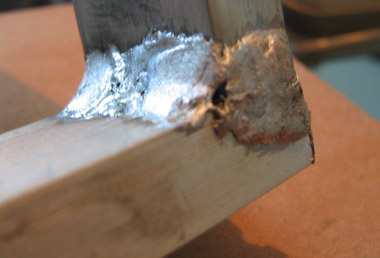aluminum welding in the developing world
When we first arrived here, I asked my bosses where the good machine shops were in town - you know, where we can get good work done. They pointed me to our machinist, KC, who runs the Jai Bagalamuki Engineering Workshop, and to the Balaju workshop, which was founded by the Swiss something like 25 years ago. I was informed there was no aluminum welding available. Aluminum welding became topical in the last couple of days because our current pedal-generator frame is too heavy.
About two weeks ago, Ewan and I were at the western-grade bike shop around the corner. One of their frames had a cheesed-up seat stay where the paint had been scraped away and there was an aluminum patch weld that must have been covering a crack. Two days ago, Ewan talked to those guys and they said there's this one place where you can get aluminum welding done in Kathmandu.
This morning, we set out to find that one place. We started by asking the bike shop guy where the shop was. Wouldn't that be easy if he could tell us an address, and then we could go there? Well, there are no street addresses in Nepal - none, so don't bother asking. About 5% of the streets have names. So navigation is via landmarks and neighborhoods' names. We went to the movie theater the bike guy said the shop was near, and started asking around. Every shop we went up to we said "aluminium welding?" and they pointed, like they were directing us on a mission.
Finally, we walked past a shop that had those distinctive aluminum welding rods against the wall. And then guy walked up. He was about 25; he wore hipster pants, polished black shoes with those long flat ends, an army jacket, and aviator sun glasses. This is the only man in Nepal that can weld aluminum, so we're told, and he's a 25-year-old snappy dresser. And get this, he does it with an oxy-acetalyne torch and mean flux, WWII-style.
We walked down the road, bought some aluminum e-channels, drew a box on a post-it, asked him to weld it together, got told it'll be 320 rupees since we're white, and that was the deal. Then we went down the street to get some potato chips and a cigarette from a 6-year-old kid running his mom's street stand. We came back to watch the welder since they'd done the fit-up by then, and a half-hour later, we had these welds:

Cheesy - for sure, but for now they hold. He had a guy holding the e-channels together when he welded them - this is a country where fixtures cost rupees, but there's a 47% unemployment rate, according to the CIA factbook.
The stick welding in Nepal is lousy - they don't hot-box their electrodes and there's a monsoon season, so the sticks are rusted before they're used. The training and machines are about as bad. About 10% of the welders use masks, the rest close their eyes and go for it. And the electrodes are Indian to begin with. So let's say a stick-weld done at a good shop like KC's is about 50% the strength it could be ideally. I wonder whether these aluminum welds are 50% of the strength they could be under ideal circumstances. Probably not. I don't think he got any penetration at the root - looks like he bridged the two legs together.


1 Comments:
I don't know William, I think your articles about welding--in the developing world or elsewhere--are interesting, especially when you include photos. This photo indicates to me that you're going to have to spend a lot of time with this guy if he's going to work with/for you. But maybe that would be good; he would have a professional trade for the rest of his life, and you would have someone to do aluminum welding for you. Everyone wins! I may be a little biased about your articles regarding welding; I'm your father. jwb
Post a Comment
<< Home